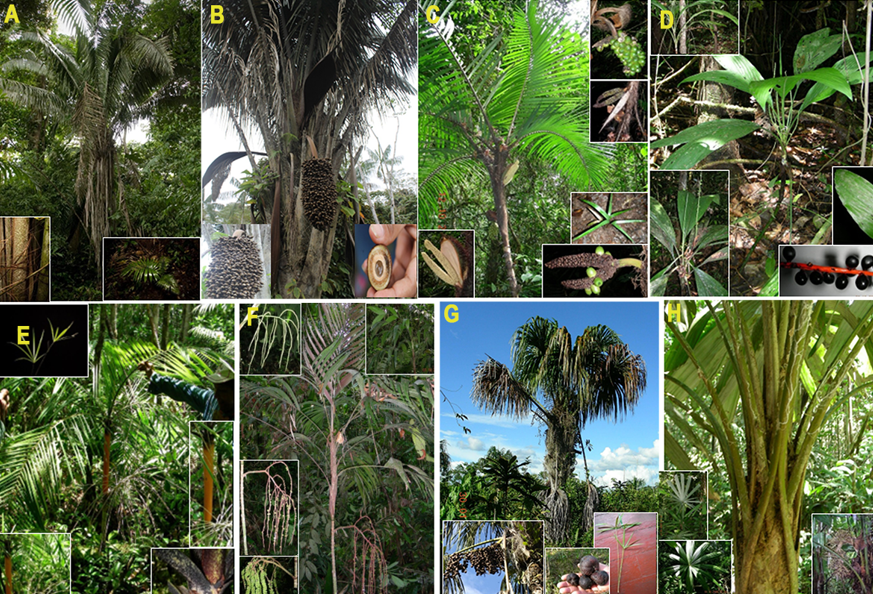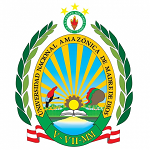Diversity of Palms in the low Amazon of the regions Loreto, Madre de Dios and Ucayali, Peru
DOI:
https://doi.org/10.55873/gentryana.v1i2.224Keywords:
inventory, species identification, transects, Peruvian AmazonAbstract
The objective of this work was to determine the diversity of palm trees in three regions of the lower Amazon (Loreto, Ucayali and Madre de Dios). The study was carried out during the Project developed in the years 2004-2013, within the framework of the Palms project. A total of 354 5 × 100 m transects were inventoried, totaling 88.50 hectares of evaluated area in the three regions. In the Loreto region, 239 transects were carried out, in Ucayali 38 transects and Madre de Dios 77 transects. A total of 97 species and 6 morphotypes were recorded. In Loreto, Oenocarpus bataua “hungurahui” was the most abundant with 28,898 ind. (10 % total of the ind.), in Ucayali Lepidocaryum tenue “irapay” with 14.379 ind. (20% of the total ind.) and in Madre de Dios Geonoma deversa “palmiche” with 5,743 individuals with the (20% of the total individuals). Loreto was the region with the greatest diversity of species with 3.601, Ucayali with 3.061 and Madre de Dios with 2.839. Between Loreto and Ucayali there was a similarity of 73% and between Ucayali and Madre de Dios 47% and between Loreto and Madre de Dios 35%. Our results show that the greatest abundance and diversity of palm species in the lower part of the Peruvian Amazon is found in the Loreto region, followed by Madre de Dios and Ucayali.
References
Baker, W. J., Dransfield, J., & Hedderson, T. A. (2000). Phylogeny, Character Evolution, and a New Classification of the Calamoid Palms. Systematic Botany, 25(2), 297. https://doi.org/10.2307/2666644
Baker, W. J., Hedderson, T. A., & Dransfield, J. (2000). Molecular Phylogenetics of Subfamily Calamoideae (Palmae) Based on nrDNA ITS and cpDNA rps16 Intron Sequence Data. Molecular Phylogenetics and Evolution, 14(2), 195–217. https://doi.org/10.1006/mpev.1999.0696
Balslev, H. (2010). Palms and Palm Communities in the Upper Ucayali River Valley—A Little-Known Region in the Amazon Basin. Palms, 54(2), 57–72.
Balslev, H., Copete, J.-C., Pedersen, D., Bernal, R., Galeano, G., Duque, Á., Berrio, J. C., & Sanchéz, M. (2016). Palm Diversity and Abundance in the Colombian Amazon. In Forest structure, function and dynamics in Western Amazonia (pp. 101–123). John Wiley & Sons, Ltd. https://doi.org/10.1002/9781119090670.ch5
Balslev, H., Laumark, P., Pedersen, D., & Grández, C. (2016). Tropical rainforest palm communities in Madre de Dios in Amazonian Peru. Revista Peruana de Biología, 23(1), 3–12. https://doi.org/10.15381/rpb.v23i1.11828
Bremer, K. (2000). Early Cretaceous lineages of monocot flowering plants. Proceedings of the National Academy of Sciences, 97(9), 4707–4711. https://doi.org/10.1073/pnas.080421597
Cámara-Leret, R., Tuomisto, H., Ruokolainen, K., Balslev, H., & Munch Kristiansen, S. (2017). Modelling responses of western Amazonian palms to soil nutrients. Journal of Ecology, 105(2), 367–381. https://doi.org/10.1111/1365-2745.12708
Copete Maturana, J. C., Cámara Leret, R., Sánchez, M., & Balslev, H. (2019). Relación entre la composición florística y los nutrientes del suelo en comunidades de palmas del Chocó biogeográfico en Colombia y Ecuador. Revista de Biología Tropical, 67(4). https://doi.org/10.15517/rbt.v67i4.34044
Dransfield, J. (1986). A Guide to Collecting Palms. Annals of the Missouri Botanical Garden, 73(1), 166. https://doi.org/10.2307/2399148
Dransfield, J. (2008). Genera Palmarum: The Evolution and Classification of Palms (2nd ed.). Kew Pub.
Dransfield, J., Uhl, N. W., Asmussen, C. B., Baker, W. J., Harley, M. M., & Lewis, C. E. (2005). A New Phylogenetic Classification of the Palm Family, Arecaceae. Kew Bulletin, 60(4), 559–569.
Henderson, A., Borchsenius, F., & Balslev, H. (2008). New species of Geonoma (Palmae) from Ecuador. Brittonia, 60(2), 190–201. https://doi.org/10.1007/s12228-008-9032-1
Kristiansen, T., Svenning, J.-C., Eiserhardt, W. L., Pedersen, D., Brix, H., Munch Kristiansen, S., Knadel, M., Grández, C., & Balslev, H. (2012). Environment versus dispersal in the assembly of western Amazonian palm communities. Journal of Biogeography, 39(7), 1318–1332. https://doi.org/10.1111/j.1365-2699.2012.02689.x
Kristiansen, T., Svenning, J.-C., Pedersen, D., Eiserhardt, W. L., Grández, C., & Balslev, H. (2011). Local and regional palm (Arecaceae) species richness patterns and their cross-scale determinants in the western Amazon. Journal of Ecology, 99(4), 1001–1015. https://doi.org/10.1111/j.1365-2745.2011.01834.x
Moore, H. (1973). Palms in the tropical forest ecosystems of Africa and South America. In Tropical Forest Ecosystems in Africa and South America: A comparative Review (pp. 63–68). Smithsonian Institution Press.
Pennington, R. T., & Dick, C. W. (2004). The role of immigrants in the assembly of the South American rainforest tree flora. Philosophical Transactions of the Royal Society of London. Series B: Biological Sciences, 359(1450), 1611–1622. https://doi.org/10.1098/rstb.2004.1532
Pintaud, J.-C., Galeano, G., Balslev, H., Bernal, R., Borchsenius, F., Ferreira, E., De Granville, J.-J., Mejía, K., Millán, B., Moraes, M., Noblick, L., Stauffer, F. W., & Kahn, F. (2008). Las palmeras de América del Sur: diversidad, distribución e historia evolutiva. Revista Peruana de Biología, 15(3), 007–029. https://doi.org/10.15381/rpb.v15i3.2662
Pintaud, J., Rodriguez del Castillo, A., Ferreira, E., Moraes, M., & Mejía, K. (2016). Towards a Revision of Attalea in Western Amazonia. Palms, 60(2), 57–77.
Porro, R., Lopez-Feldman, A., & Vela-Alvarado, J. W. (2015). Forest use and agriculture in Ucayali, Peru: Livelihood strategies, poverty and wealth in an Amazon frontier. Forest Policy and Economics, 51, 47–56. https://doi.org/10.1016/j.forpol.2014.12.001
R Core Team. (2021). R: A Language and Environment for Statistical Computing. R Foundation for Statistical Computing. R Foundation for Statistical Computing. https://www.r-project.org/
Raven, P., & Axelrod, D. (1972). Plate Tectonics and Australasian Paleobiogeography: The complex biogeographic relations of the region reflect its geologic history. SCIENCE, 176(4042), 1379–1386. https://www.science.org/doi/10.1126/science.176.4042.1379
Rodríguez Achung, F., Limachi Huallpa, L., Maco García, J., Escobedo Torres, R., Reátegui Reátegui, F., Ramírez Barco, J., García Altamirano, A., Castro Medina, W., Fachín Malaverri, L., Cadenillas Ordinola, R., Pereyra Panduro, G., Encarnación Cajañaupa, F., Zárate Gómez, R., & Ahuite Reátegui, M. (2008). Madre de Dios, camino al desarrollo sostenible: Propuesta de zonificación ecológica económica del Departamento de Madre de Dios. Instituto de Investigaciones de la Amazonía Peruana. https://hdl.handle.net/20.500.12921/528
Rojas Gonzáles, R., & van der Werff, H. (2010). Flora del Río Cenepa, Amazonas, Perú (1st ed.). Missouri Botanical Garden Press.
Rondoni, C. (2022). Extractivism and Unjust Food Insecurity for Peru’s Loreto Indigenous Communities. Sustainability, 14(12), 6954. https://doi.org/10.3390/su14126954
Torres-Slimming, P. A., Wright, C. J., Lancha, G., Carcamo, C. P., Garcia, P. J., Ford, J. D., & Harper, S. L. (2020). Climatic Changes, Water Systems, and Adaptation Challenges in Shawi Communities in the Peruvian Amazon. Sustainability, 12(8), 3422. https://doi.org/10.3390/su12083422
Trénel, P., Gustafsson, M. H. G., Baker, W. J., Asmussen-Lange, C. B., Dransfield, J., & Borchsenius, F. (2007). Mid-Tertiary dispersal, not Gondwanan vicariance explains distribution patterns in the wax palm subfamily (Ceroxyloideae: Arecaceae). Molecular Phylogenetics and Evolution, 45(1), 272–288. https://doi.org/10.1016/j.ympev.2007.03.018
Vásquez Martinez, R. (1997). Flórula de las Reservas Biológicas de Iquitos, Perú. Allpahuayo-Mishana, Explornapo Camp, Explorama Lodge (Missouri Botanical Garden (ed.)). Intituto de Investigación de la Amazonía Peruana. http://biblioteca.iiap.gob.pe/cgi-bin/koha/opac-detail.pl?biblionumber=751
Vormisto, J., Tuomisto, H., & Oksanen, J. (2004). Palm distribution patterns in Amazonian rainforests: What is the role of topographic variation? Journal of Vegetation Science, 15(4), 485–494. https://doi.org/10.1111/j.1654-1103.2004.tb02287.x
Vuohelainen, A. J., Coad, L., Marthews, T. R., Malhi, Y., & Killeen, T. J. (2012). The Effectiveness of Contrasting Protected Areas in Preventing Deforestation in Madre de Dios, Peru. Environmental Management, 50(4), 645–663. https://doi.org/10.1007/s00267-012-9901-y

Published
How to Cite
Issue
Section
License
Copyright (c) 2023 César Augusto Grández-Rios, Henrik Balslev , Carlos Darwin Angulo-Villacorta, Roberto Pezo-Diaz

This work is licensed under a Creative Commons Attribution 4.0 International License.
The authors, knowing that the GENTRYANA journal has an Open Access policy (Open Access) accept the conditions of the Creative Commons Attribution 4.0 International LICENSE (CC BY 4.0).







